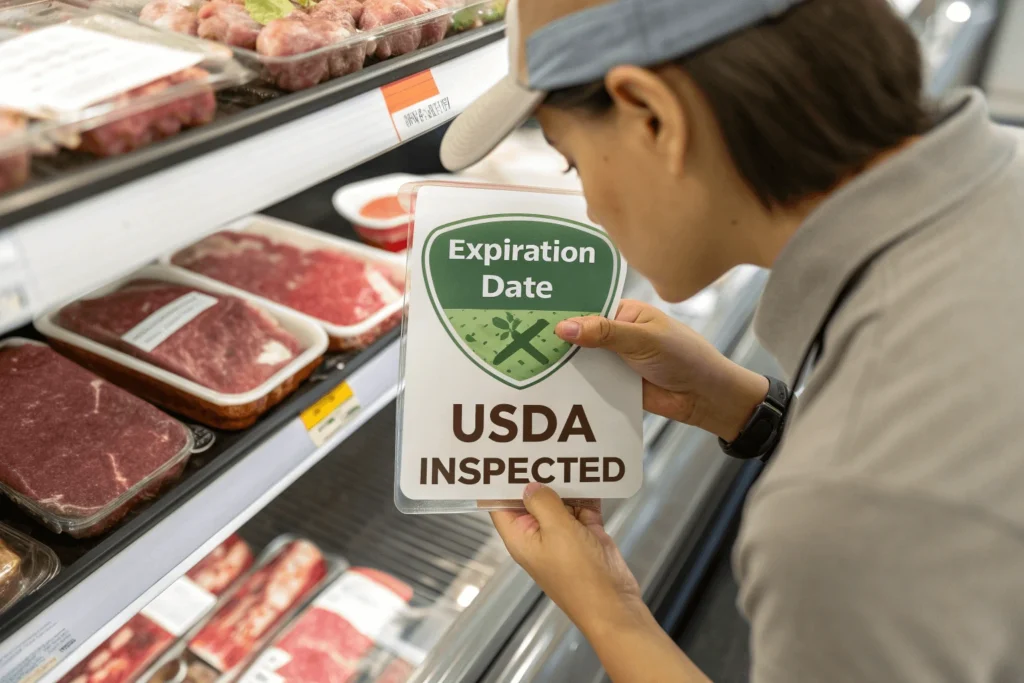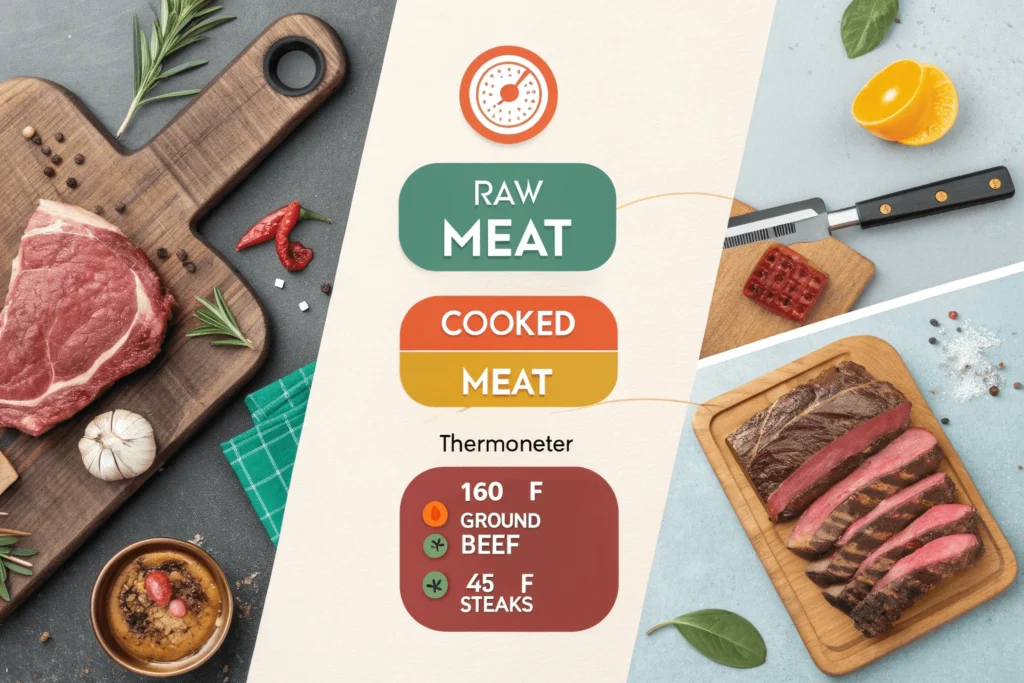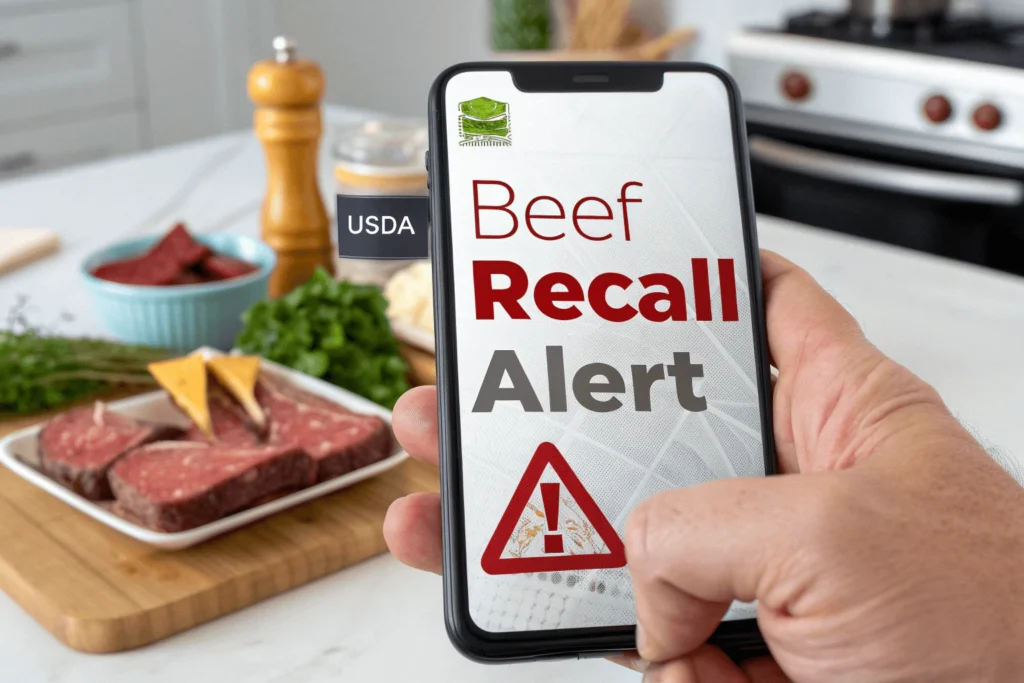Table of Contents
Beef recalls are an essential part of maintaining food safety and protecting public health. When contamination or other safety concerns arise, these recalls act as a safeguard to prevent potentially harmful products from reaching consumers. Whether it’s due to bacterial contamination like E. coli or Salmonella, or mislabeling of allergens, beef recalls highlight the importance of vigilance in the food supply chain.
For consumers, understanding what beef recalls are, why they happen, and how to respond is critical to ensuring the safety of their families. In this guide, we’ll explore everything you need to know about beef recalls, from identifying affected products to taking proactive steps to stay informed. By the end, you’ll have the knowledge you need to navigate these situations with confidence and prioritize food safety in your home.
What Is a Beef Recall and What Causes It?
Beef recalls are a critical tool in ensuring the safety of the food supply chain. They protect consumers from harmful or potentially life-threatening foodborne illnesses and other hazards. This section dives deeper into what beef recalls entail, why they occur, and the key players responsible for regulating and managing these recalls.
Definition of a Beef Recall: What It Means and Why It’s Important
A beef recall occurs when a company voluntarily or under regulatory pressure removes beef products from the market due to safety concerns. This measure aims to prevent public exposure to products that may cause harm, whether due to contamination, mislabeling, or production errors.
Why It’s Important:
- Protects consumers from health risks such as E. coli, Salmonella, or allergens.
- Maintains public trust in food safety systems.
- Encourages accountability within the food production industry.
Beef recalls serve as a proactive approach to minimize the spread of foodborne illnesses and ensure consumer well-being.
- Common Causes of Beef RecallsSeveral factors can lead to a beef recall. Understanding these causes helps consumers become more aware of potential risks and take appropriate precautions.
- Bacterial Contamination:
- E. coli: Often associated with undercooked or improperly handled ground beef, this bacteria can cause severe illness, especially in vulnerable groups.Salmonella: Another common contaminant in beef, leading to symptoms like diarrhea, fever, and abdominal cramps.Listeria monocytogenes: Found in some ready-to-eat beef products, Listeria is particularly dangerous for pregnant women, newborns, and older adults.
- Products may lack proper allergen warnings (e.g., undeclared soy or gluten).Incorrect labeling can lead to unintended health risks for consumers with allergies.
- Occasionally, beef products are recalled due to the presence of foreign objects like metal, plastic, or bone fragments.
- Inadequate cooking or packaging procedures during production can compromise safety.
- Bacterial Contamination:
USDA and FDA’s Role: How These Agencies Regulate and Announce Recalls
- The United States Department of Agriculture (USDA) and the Food and Drug Administration (FDA) play vital roles in managing beef recalls.
- USDA’s Food Safety and Inspection Service (FSIS):
FSIS oversees meat, poultry, and egg product recalls. They monitor production facilities, test products for contaminants, and issue recall notices to inform the public.FDA’s Involvement:
While the FDA primarily oversees other food products, it collaborates with the USDA to ensure safety in shared areas, such as food packaging or additives.
- Official press releases and recall notices are published on government websites (e.g., USDA FSIS).Media outlets, grocery stores, and online platforms share updates to inform consumers.Mobile apps and email alerts provide real-time updates for those subscribed to recall notifications.
- USDA’s Food Safety and Inspection Service (FSIS):
Examples of Recent Beef Recalls: Highlighting Notable Cases for Context
- Examining past beef recalls provides insight into the scale and impact of these safety measures:
- E. coli Outbreak Recall (2023):
A major recall was issued for several brands of ground beef due to E. coli contamination, impacting over 100,000 pounds of products.Foreign Material Recall (2024):
A company recalled prepackaged beef due to reports of metal fragments found in the meat.Listeria Contamination (2022):
Ready-to-eat beef products were recalled after testing positive for Listeria, posing a serious risk to vulnerable consumers.
- E. coli Outbreak Recall (2023):

How to Identify Recalled Beef Products
Identifying recalled beef products is a critical step in ensuring the safety of your family and avoiding potential health risks. By staying informed and knowing where to look for reliable information, you can quickly determine whether the beef in your kitchen is affected. Below are the steps and tools to help you recognize recalled products effectively.
Checking Recall Notices: Where to Find Official Updates
The USDA and FSIS (Food Safety and Inspection Service) are primary authorities responsible for announcing beef recalls in the United States. Here’s how you can access their updates:
- USDA Recall Database: The USDA maintains an online database where you can search for recent recalls. It provides detailed information about the affected products, including batch numbers and packaging details.
- FSIS Website: The FSIS regularly publishes recall notices on its website, which include reasons for the recall, distribution areas, and specific safety instructions.
- Press Releases: Recalls are often announced through press releases, which may be shared by news outlets, government agencies, or health organizations.
By checking these official sources frequently, you can stay up-to-date on the latest beef recalls.
Key Details to Look For: Labels, Product Codes, and Packaging Dates
When examining your beef products, focus on the following details to determine if they match recall notices:
- Product Labels: Carefully read the label for brand names, product descriptions, and weights that match the recall notice.
- Product Codes: Check for lot numbers, establishment codes (e.g., “EST. 12345”), and other unique identifiers printed on the packaging.
- Packaging Dates: Look for specific production or use-by dates mentioned in the recall notice.
- Distribution Locations: Verify whether the recall applies to your region, as some recalls may be limited to specific states or retailers.
Having this information handy will allow you to compare your products against recall notices quickly.
Retailer Notifications: How Stores Communicate Recalls to Consumers
Retailers play a significant role in informing customers about recalls. Here’s everything you should understand about their process:
- In-Store Alerts: Many grocery stores post recall notices at customer service desks or near meat departments. Look for signs or flyers with product details.
- Receipts and Loyalty Programs: If you purchased the recalled beef using a loyalty program, some stores may notify you directly via email or phone based on purchase history.
- Website Updates: Retailers often publish recall notices on their websites or social media pages to reach a broader audience.
Don’t hesitate to ask store employees for clarification or assistance if you suspect you’ve purchased a recalled product.
Using Technology: Apps and Tools to Stay Updated on Recalls
Technology offers several convenient ways to stay informed about beef recalls:
- Recall Alert Apps: Apps like the USDA’s “FoodKeeper” or others dedicated to food safety send notifications about recent recalls directly to your smartphone.
- Social Media Updates: Follow USDA, FSIS, and trusted retailers on platforms like Twitter and Facebook for real-time updates.
- Subscription Services: Sign up for email alerts or newsletters from the USDA or FSIS to get recall information delivered to your inbox.
- Barcode Scanners: Use apps that allow you to scan product barcodes to check if they are affected by recalls.
By leveraging these tools, you can take proactive steps to identify recalled beef products and ensure they don’t pose a risk to your household.
Summary of the Section
Recognizing recalled beef products requires vigilance and the use of reliable resources. Whether you’re checking official databases, examining product details, relying on retailer notifications, or using technology, staying informed is key to protecting your family’s health.
Risks of Consuming Contaminated Beef
Consuming contaminated beef poses serious health risks that can lead to foodborne illnesses, some of which may result in severe complications or even hospitalization. Understanding these risks can help consumers take necessary precautions to protect themselves and their families.
Health Concerns: Symptoms of Foodborne Illnesses Caused by E. coli, Salmonella, and Listeria
- E. coli Contamination:
- Symptoms: Severe stomach cramps, diarrhea (often bloody), vomiting, and fever.
- Complications: In some cases, E. coli infections can lead to hemolytic uremic syndrome (HUS), a life-threatening condition causing kidney failure.
- Salmonella Infection:
- Symptoms: Nausea, vomiting, abdominal cramps, diarrhea, fever, and headache.
- Complications: For individuals with weakened immune systems, Salmonella can enter the bloodstream, causing severe infections in organs like the heart or bones.
- Listeria Monocytogenes:
- Symptoms: Fever, muscle aches, headache, stiff neck, confusion, and diarrhea.
- Complications: Listeria is particularly dangerous for pregnant women, potentially causing miscarriage, stillbirth, or severe illness in newborns.
Vulnerable Groups: Impact on Children, Elderly, and Immunocompromised Individuals
- Children:
- Their developing immune systems make children more susceptible to severe complications, such as dehydration from diarrhea or HUS caused by E. coli.
- Elderly Individuals:
- Older adults often have weakened immune systems, making it harder to fight infections. Contaminated beef can lead to prolonged illnesses or complications such as sepsis.
- Immunocompromised Individuals:
- People with weakened immune systems, such as those undergoing chemotherapy, transplant recipients, or individuals with chronic illnesses (like diabetes), are at higher risk of life-threatening complications.
- Pregnant Women:
- Listeria poses a unique risk, potentially causing pregnancy complications and severe health issues for the baby.
Outbreaks and Statistics: Data on Foodborne Illnesses from Beef Contamination
- Recent Outbreaks:
- Highlight cases such as E. coli outbreaks in ground beef products or Salmonella contaminations linked to undercooked steak.
- Statistics:
- According to the CDC, approximately 48 million Americans get sick from foodborne illnesses every year, with a significant percentage linked to contaminated beef.
- E. coli O157:H7 causes about 73,000 illnesses annually in the U.S., often associated with beef.
- Impact of Beef Recalls:
- Major recalls often involve thousands of pounds of beef, reflecting the scale of potential exposure and the importance of regulatory oversight.
Importance of Early Action: Seeking Medical Attention for Symptoms
- Recognizing Symptoms Early:
- Understanding the initial signs of infection can prevent more severe complications. For example, blood in stool or high fever after consuming beef should prompt immediate action.
- Consulting a Healthcare Provider:
- If foodborne illness symptoms appear, contacting a doctor is crucial, especially for vulnerable groups. Testing can identify the cause, and early treatment can reduce complications.
- Reporting Illnesses:
- Reporting suspected cases of foodborne illnesses to local health departments helps trace the source of contamination and prevents further spread.
- Avoiding Further Spread:
- Proper hygiene, like frequent handwashing and avoiding food preparation when ill, is critical to prevent spreading infections to others.
What to Do If You Have Recalled Beef
Discovering that a product you purchased has been recalled can be concerning, but knowing the right steps to take can help you act swiftly and protect your household. Here’s a detailed guide on what to do if you have recalled beef:
Steps to Take: Stop Consumption Immediately
- Cease Use of the Product: The moment you identify that the beef in your possession has been recalled, stop consuming it right away. Consuming contaminated beef can lead to serious health risks, such as foodborne illnesses caused by E. coli or Salmonella.
- Inspect the Product: Check the product’s label for important details like batch numbers, packaging dates, and product codes. These details can confirm if your purchase is part of the recall.
- Isolate the Product: To avoid accidentally using the beef or cross-contaminating other foods, separate it from your other groceries and store it securely in a sealed container.
Refund and Replacement Policies: What Stores and Manufacturers Offer
- Return the Product: Many stores have policies in place for recalled items. Bring the product back to the store where you purchased it to request a refund or replacement.
- No Receipt Needed: In most cases, you won’t need proof of purchase, as recalls are widely publicized and stores are informed.
- Contact the Manufacturer: Some manufacturers provide direct refunds or replacements for recalled products. Check the recall notice for contact details and instructions.
- Understand the Policy Timeline: Act promptly, as some stores or manufacturers might have specific timeframes for returns or refunds related to recalls.
Proper Disposal of Contaminated Meat
- Do Not Consume: Even if the beef appears normal, avoid cooking or tasting it—it may still contain harmful bacteria.
- Safe Disposal Methods: Place the product in a sealed plastic bag to prevent leakage and dispose of it in a way that prevents animals or others from accessing it.
- Clean Contaminated Areas: If the beef has come into contact with utensils, cutting boards, or countertops, thoroughly clean and disinfect these surfaces to eliminate any potential bacteria.
- Avoid Composting: Never compost contaminated beef, as bacteria can survive and spread through composted material.
Contacting Authorities: Reporting Issues to USDA or FDA
Here’s a reliable site for staying informed about food recalls, including beef recalls:
This site provides up-to-date information about recalls, including meat products, and offers detailed recall notices from the USDA, making it a valuable resource for consumers. You can link this as an outbound link in your blog for added credibility,
This is the official page where the USDA posts the most current recall notices, including beef and other meat products.
- File a Complaint: If you suspect an illness linked to recalled beef or notice a food safety violation, report it to the USDA Food Safety and Inspection Service (FSIS) or the FDA.
- Hotline Numbers: The USDA operates a Meat and Poultry Hotline (1-888-MPHotline) to handle consumer concerns and complaints.
- Online Reporting: Use the USDA’s electronic complaint form to provide details about the product and where it was purchased.
- Why Reporting Matters: Sharing your experience helps authorities track the scope of the issue, ensuring timely action and preventing further harm.
By following these steps, you can minimize risks, protect your family, and contribute to food safety efforts. Taking action quickly ensures that contaminated beef is safely removed from circulation and that proper measures are taken to address the issue.

How to Protect Yourself from Beef Recalls
Beef recalls can be concerning, but by following proactive measures, you can significantly reduce the risks associated with contaminated or unsafe meat products. Here are practical tips to help you safeguard your health and ensure the food you consume is safe.
Safe Meat Handling Practices: Proper Cooking Temperatures and Storage Guidelines
Proper handling and cooking of beef are key to minimizing the risks of foodborne illnesses:
- Cooking Temperatures: Always cook beef to the recommended internal temperature of 160°F (71°C) for ground beef and 145°F (63°C) for steaks and roasts (followed by a rest time of 3 minutes). Use a meat thermometer for accuracy.
- Avoid Cross-Contamination: Keep raw beef separate from other foods in your kitchen. Keep separate cutting boards, utensils, and containers for raw and cooked meat.
- Proper Storage: Store raw beef in the refrigerator at 40°F (4°C) or lower. If you’re not using it within 1-2 days, freeze it at 0°F (-18°C) to maintain freshness.
- Defrost Safely: Thaw frozen beef in the refrigerator, not on the counter, to prevent bacterial growth.
Shopping Smart: Choosing Trusted Brands and Inspecting Products
Being selective and vigilant when buying beef can help reduce the risk of purchasing contaminated products:
- Buy From Trusted Sources: Purchase beef from reputable retailers and brands known for their safety standards. Avoid discounted or poorly stored meat that may have been mishandled.
- Check Labels and Dates: Look for clear labels with processing dates, expiration dates, and proper packaging. Avoid beef with torn or damaged packaging.
- Inspect the Product: Fresh beef should be bright red and free from unpleasant odors. If the color or smell seems off, avoid buying it.
- Know Your Cuts: Be aware of the specific cuts of beef often involved in recalls, like ground beef, as they are more prone to contamination.

Staying Informed: Subscribing to USDA Recall Alerts and Checking Updates Regularly
Staying updated on beef recalls ensures you can act quickly if a product you’ve purchased is affected:
- Sign Up for Alerts: Subscribe to email or SMS alerts from the USDA Food Safety and Inspection Service (FSIS) or FDA to receive timely notifications about recalls.
- Use Technology: Leverage apps and websites like FoodKeeper or Recalls.gov to stay informed about food safety and recall information.
- Social Media and News Outlets: Follow reputable food safety organizations and news sources for the latest updates on recalls.
- Check Retailer Websites: Many grocery stores post recall notices on their websites or in-store, so review these regularly if you shop there often.
Long-Term Food Safety Tips: Preventive Measures to Reduce Risks at Home
In addition to responding to recalls, adopting long-term food safety habits can help protect your family:
- Rotate Your Stock: Practice FIFO (First In, First Out) by using older products first and regularly checking for expired items.
- Buy Smaller Quantities: Purchase only what you can use within a few days to reduce the risk of spoilage.
- Keep Your Kitchen Clean: Regularly sanitize cutting boards, countertops, and utensils to prevent cross-contamination.
- Educate Your Family: Teach household members about proper food safety practices to ensure everyone contributes to a safe kitchen environment.
- Be Prepared: In case of a recall, have a clear plan for checking products, disposing of contaminated items, and seeking replacements or refunds.
Conclusion
Beef recalls are a vital tool in ensuring food safety, protecting consumers from potential health risks, and maintaining trust in the food supply chain. By understanding the reasons behind recalls, learning how to identify affected products, and knowing what actions to take, you can safeguard your family’s health with confidence.
Proactive steps like practicing safe meat handling, staying informed about recalls through trusted sources, and adopting long-term food safety habits are key to reducing risks and creating a safer kitchen environment. Remember, food safety starts with awareness and action.
Whether you’re dealing with a current recall or simply want to stay prepared, the knowledge and tips shared in this guide will help you navigate these situations effectively. Stay vigilant, stay informed, and prioritize safety to enjoy your meals with peace of mind.



2 thoughts on “Everything You Need to Know About Beef Recalls: What to Look For and How to Stay Safe”
Comments are closed.